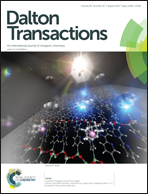Correlation between band alignment and enhanced photocatalysis: a case study with anatase/TiO2(B) nanotube heterojunction†
Abstract
It has long been known that efficient interfacial charge transfer between different phases of TiO2 is beneficial for enhanced photocatalysis. However, there has been considerable debate over the direction of the charge transfer across the interface of the different TiO2 phases. In this work, we study the case of TiO2 with a novel anatase/TiO2(B) heterojunction (ABHJ), wherein charge carrier transfer across the heterojunction interface is intensively investigated. The ABHJ is prepared by a two-step alkaline hydrothermal route and features nanotubes with a large surface area. Comprehensive analysis including UV-Vis-DRS, XPS, Mott–Schottky measurements, EPR and transient photovoltage techniques provides evidence for a type II band alignment in the ABHJ and migration of the photogenerated electrons from anatase to TiO2(B), which could effectively inhibit the recombination rate of photo-induced electron–hole pairs. Photocatalytic tests demonstrate that the as-obtained ABHJ shows higher activity than both the single phase and P25, not only for hydrogen production, but also for the photodegradation of gaseous acetaldehyde, which is due to the synergistic effect between an efficient charge separation at the interface and a high surface area.


 Please wait while we load your content...
Please wait while we load your content...